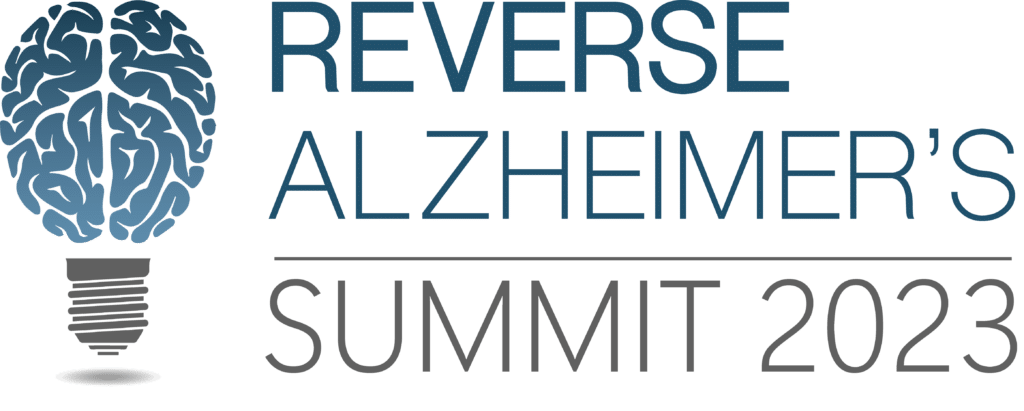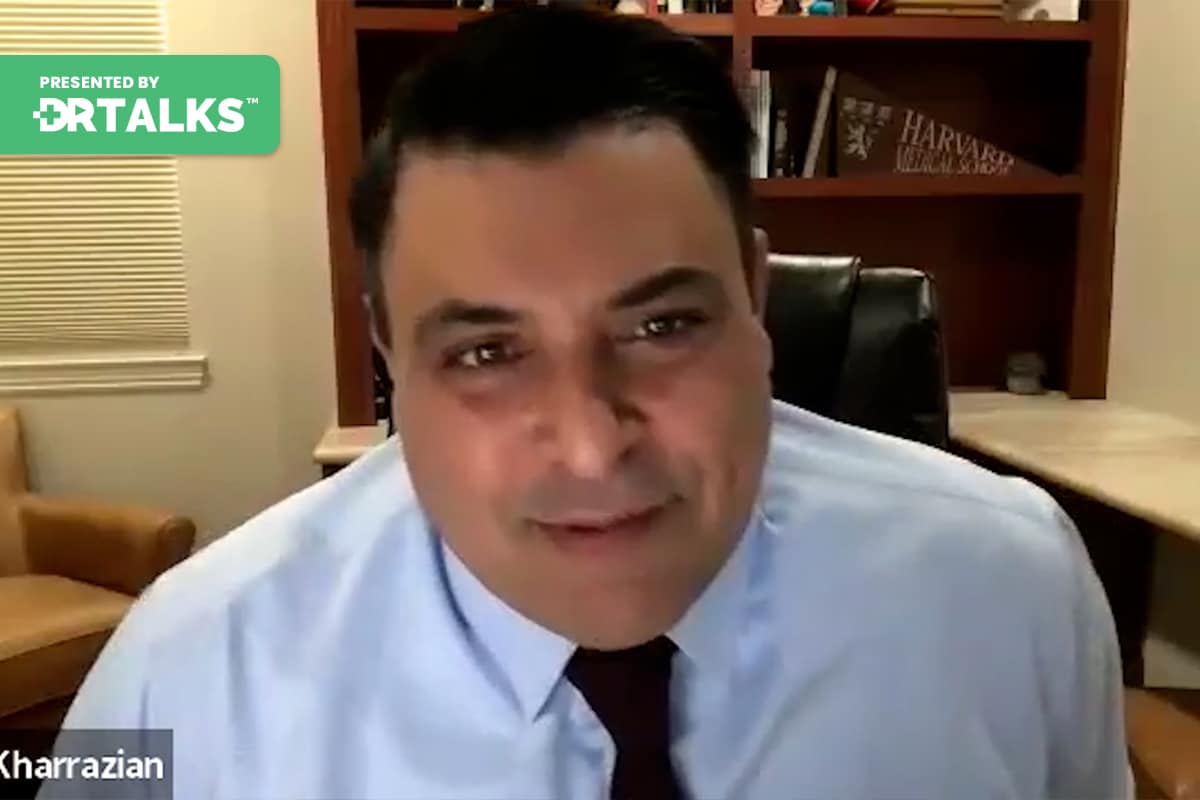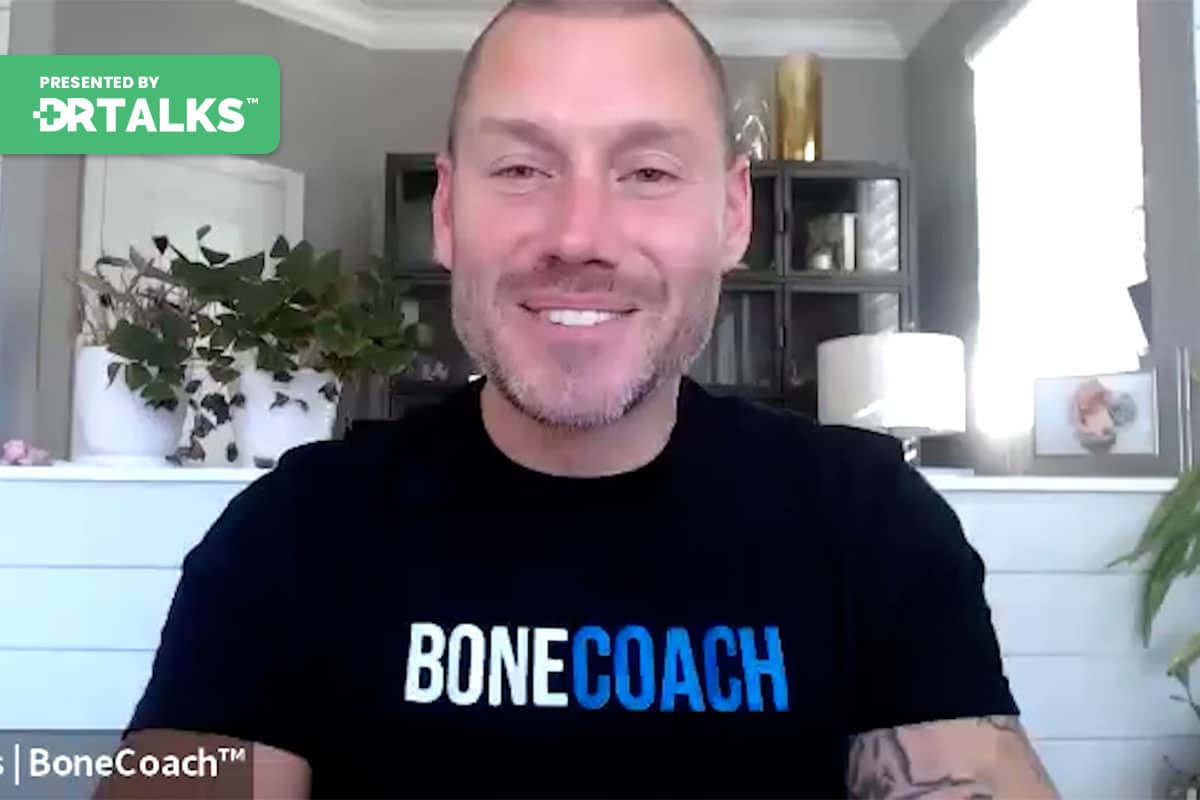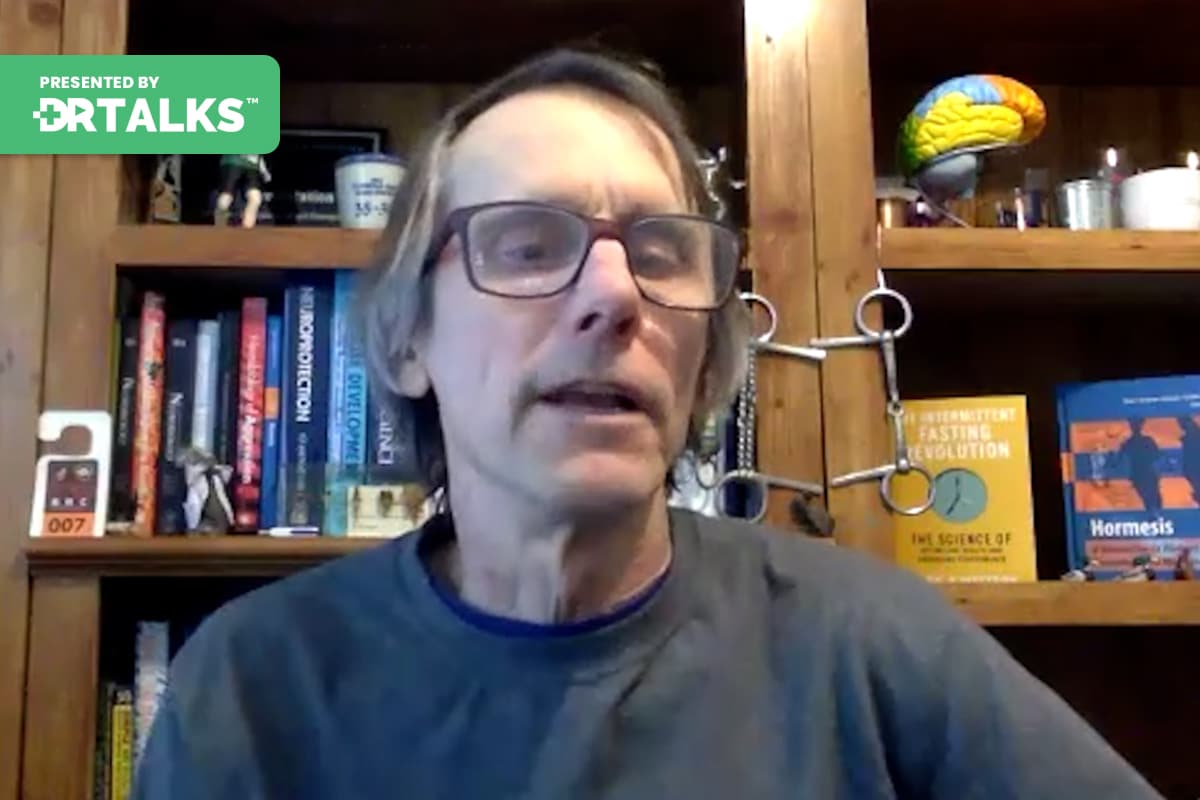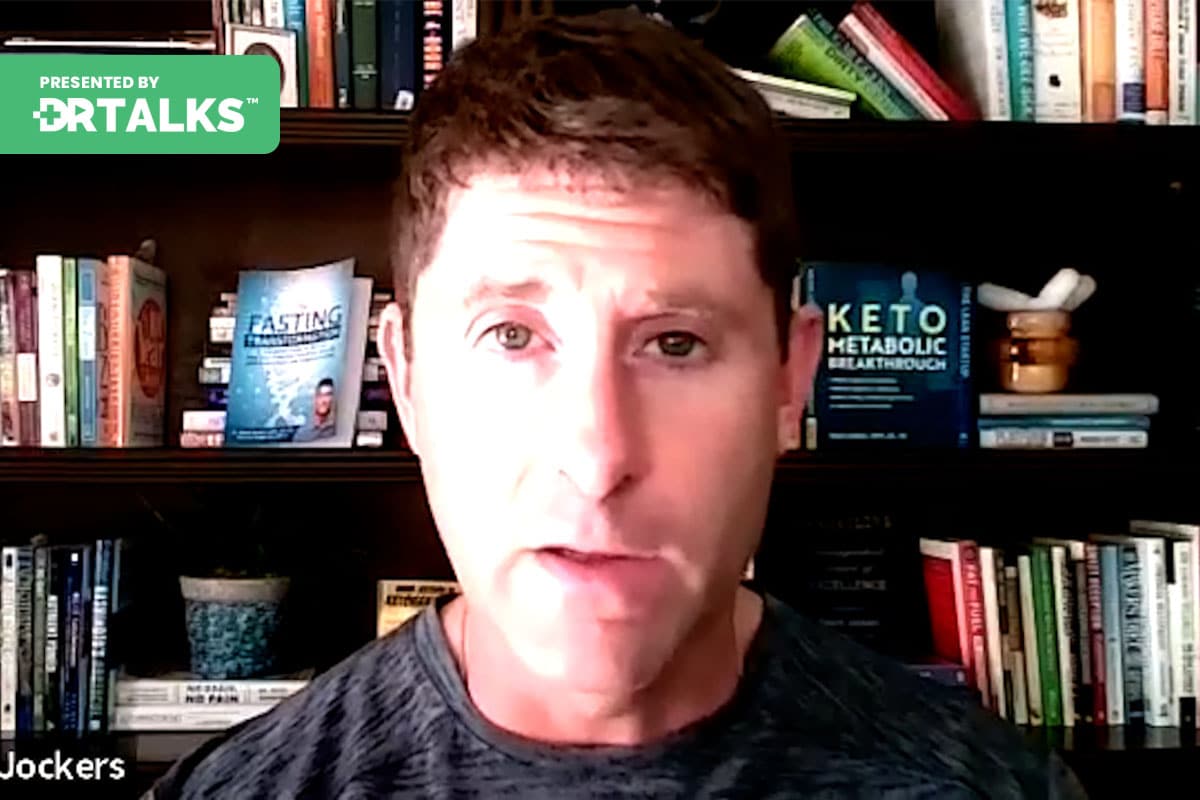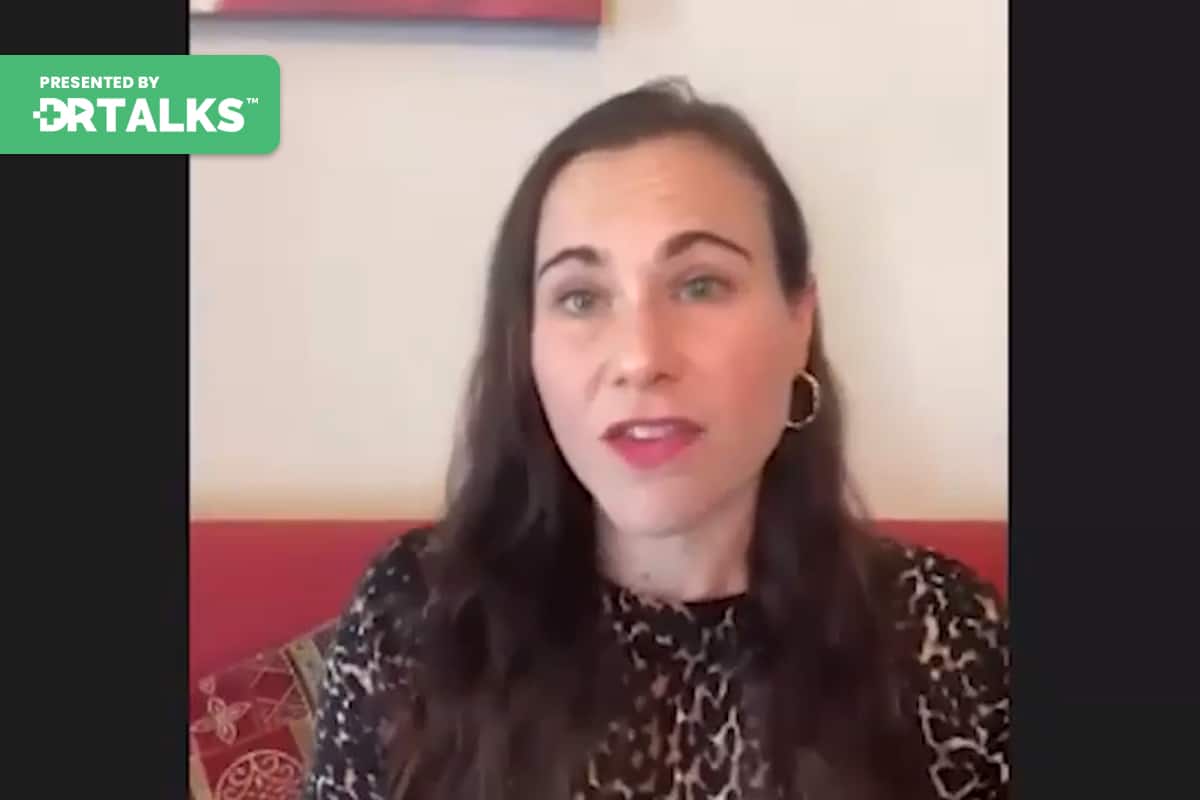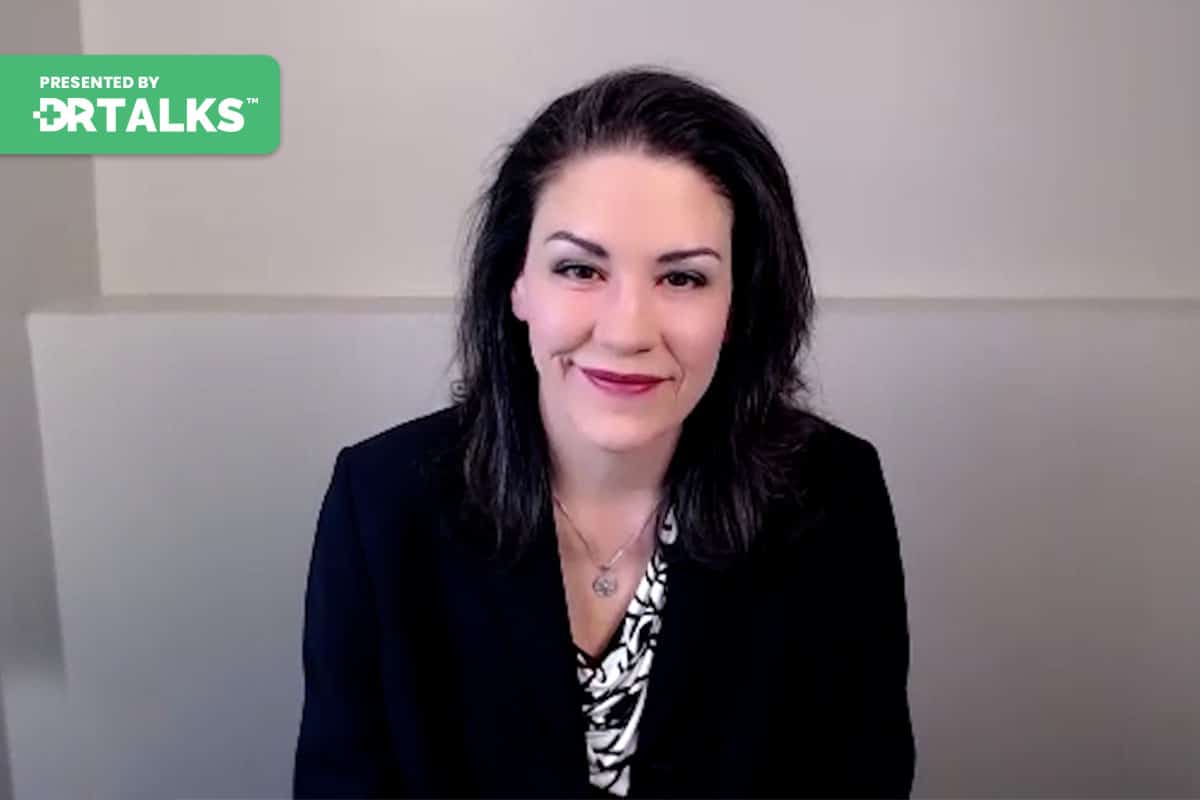Join the discussion below

Dr. Heather Sandison is the founder of Solcere Health Clinic and Marama, the first residential care facility for the elderly of its kind. At Solcere, Dr. Sandison and her team of doctors and health coaches focus primarily on supporting patients looking to optimize cognitive function, prevent mental decline, and reverse... Read More
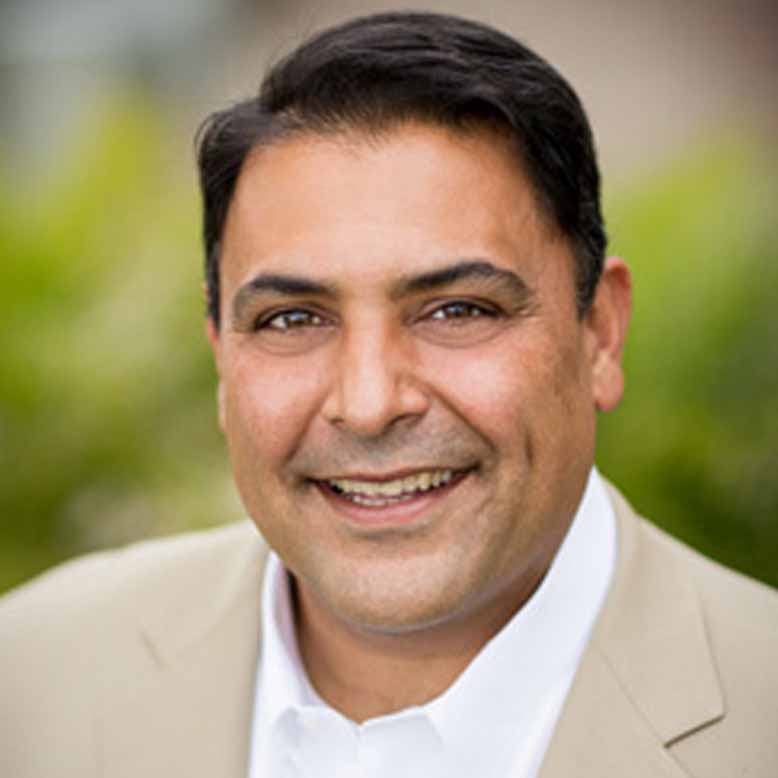
Dr. Datis Kharrazian is a clinical research scientist, academic professor, and a functional medicine health care provider. He is Associate Clinical Professor at Loma Linda University School of Medicine and a Research Fellow at Harvard Medical School and a researcher at the Department of Neurology at Massachusetts General Hospital. Dr.... Read More
Dr. Datis Kharrazian uses his experiences from Harvard to teach you about the role of traumatic brain injuries in cognitive decline
- Understand the outcomes of brain trauma that happen years after the injury
- Discover how brain injury and Alzheimer’s Disease overlap in degenerative changes
Heather Sandison, ND
Welcome to this episode of the Reverse Alzheimer’s Summit. I’m your host, Dr. Heather Sandison, and I’m delighted to introduce you to Dr. Datis Kharrazian today. He is an associate clinical professor at Loma Linda University School of Medicine, a research fellow at Harvard Medical School, and the Department of Neurology at Mass General Hospital. He is also a fellow of the American College of Nutrition and a faculty for the Institute of Functional Medicine. Welcome, Dr. Kharrazian.
Datis Kharrazian, PhD, DHSc, DC, MS, MMSc, FACN
Thank you so much.
Heather Sandison, ND
So I can not wait to share with everyone what you found for those who are suffering with traumatic brain injuries. We know that this is a risk factor when it comes to developing dementia, or memory loss, and impairment later in life. Yet there is so much more that we can do about it than I think people realize. You and I have shared a couple of patients and one in particular has suffered from a traumatic brain injury after a military career. I have seen the work that you do. I have heard firsthand how it can benefit people and I’m really, really excited to share it with our audience.
Datis Kharrazian, PhD, DHSc, DC, MS, MMSc, FACN
Yeah, absolutely. Head injuries are totally overlooked and one of the main problems with head injuries is that people have this thought that if you get a head injury, all your deficit is lost right after the injury. But all the current understandings of head injuries, which is in the field what is called chronic traumatic encephalopathy, CTE, is that the symptoms are going to show up years and years later. So, it is basically the head injury, the head trauma ignites the fire like in the forest, starts to burn up, and then it could be years and years and years when a person really starts to notice some deficits. It could be five years. It could be 10 years. It could be two years. So then they have a hard time trying to associate their symptoms of cognitive decline and brain function, and maybe mood disorders and depression, and sleep imbalances with head trauma. Then they get regular routine lab tests that are just going to show they do not have a metabolic disease and they are going to be frustrated and they are going to be a confused, weird patient and then no one is going to believe them. And they go through this whole episode of not knowing what is happening, being confused, and getting really frustrated throughout the process.
Heather Sandison, ND
So, you mentioned sleep even, and I can only imagine that if you start stacking these risk factors on top of each other, right? You have a traumatic brain injury and now you are not able to sleep as well. Maybe there is extra stressors, particularly for people in a military situation, less so in a sports situation, or even in a domestic violence situation where there is physical head traum but there is also a lot of stress associated. Then if somebody isn’t getting great nutrition, they are not getting exercise, it is almost this downhill spiral in terms of brain health.
Datis Kharrazian, PhD, DHSc, DC, MS, MMSc, FACN
In particular with brain injury, one phenomenon that occurs with it that is a little bit different than conventional Alzheimer’s disease is with the traumatic injury to the brain, the immune cells in the brain called microglia become really active. They become primed and they become extremely sensitive to inflammation that is caused by anything, whether it is their diet or environmental triggers, or if they get an infection, they get symptoms right away. These glial cells, once they get primed, they just stay there and they just cause this constant inflammatory response and one of the biggest clues someone has glial priming is the neurological deficit symptoms from trivial exposures.
For example, someone has a milk sensitivity and for whatever reason they have it, they get exposed to milk proteins. Some people get bloated and distended if they are milk sensitive but some people may have massive vertigo. That happens with specific injury to the cerebellum or the frontal lobe may be injured and they may start to have focus, concentration, and attention issues, or someone else and their temporal lobe is injured, then they may have tinnitus. So, one interesting thing about traumatic brain injury and its impact on causing decline is that these glial cells get activated and one of the biggest clues is disproportionate responses to inflammatory triggers and the symptoms that each person will get are going to be specific to the area of the brain that was injured.
So, it is going to be different for each person. Some people get contrecoup injuries where they hit the head in the back and front of their head and they get multiple sets of lesions. But it is pretty clear that it is a neurological injury that is pressured over time that then creates these inflammatory responses. Now, these inflammatory responses for the glial cells, they turn on these same mechanisms of tau protein buildup and things like Alzheimer’s disease and eventually, they will get clogged and decline. So, the biggest clinical red flag is when someone reports that they have a disproportional response to an inflammatory trigger.
Heather Sandison, ND
Really fascinating, because you are describing something highly specific. You can point to the area of the brain that was injured and then sort of expect the response. However, people injure different parts of their brains and so, there are different responses. So, even though it can be highly specific, it is hard to connect the dots often, I would imagine.
Datis Kharrazian, PhD, DHSc, DC, MS, MMSc, FACN
Yeah, it is very hard to connect the dots. That is the thing, too, most physicians, and most health care providers learn about the brain and they pass their boards and they have some confidence in it. But when it comes to clinical applications, they are not trained to think that way but when you really think of the brain, different regions have different functions. Then when it is injured, it is inflamed and they may show up years later if the injury, they are just clear presentations. So, some can have mysterious leg numbness that only happens or face numbness and it is the parietal lobe that was injured. Or someone could have issues with falling asleep because they can inhibit reticular formation.
So all these different, weird symptoms, a lot of times are really brain injuries and they just get overlooked. And we do not really have a healthcare model even in the world of neurology, there is not really a healthcare model. We are looking at traumatic brain injury that is starting to express itself four or five years later. With an acute brain injury, I think, there are some pretty good models to immediately get in there, do some interventions. But once an injury starts the activation of these inflammatory cells in the brain called glial cells and creates that cascade, and that inflammation will then start to destroy the surrounding neurons in the area and over time, more and more of them will get degenerated, and then it actually accelerates.
Then the more inflammatory triggers they have in the lifestyle with that injury, the faster it progresses. Then they really end up not ever having anything significant enough to show up on an MRI because these inflammatory responses will not show up withroutine MRI and they do not see anything wrong with lab tests. So, the patient is completely frustrated. With a neurological exam, you can clearly see deficits like they cannot feel part of their face. We use a pinwheel or a tissue. They cannot bounce on their leg. They close their eyes and they get vertigo. There is something wrong. So, it is clearly identified through an exam, but not really through imaging or just routine bloodwork.
Heather Sandison, ND
As you mentioned, many doctors learn those exams in school, study for boards, and then forget them for the rest of their careers. So, you need to go to a highly specialized doctor who practices this regularly. Now, I want to go there, but first I want to break it down. You mentioned that there is a model that many people know for acute brain injuries and then there is a lesser-known model for what to do when symptoms are starting to present themselves many years later. So, can you take us through those two things? Because I know many of our listeners either have experienced them and maybe it has been in the past year or maybe it was 25 years ago. What do they do if they are in one of those camps?
Datis Kharrazian, PhD, DHSc, DC, MS, MMSc, FACN
So, if you have an acute brain injury, you have a six-month window, and eight-month window to make dramatic changes in the expression of this. First of all, when we look at studies that have been published in trauma journals, you will see hormones immediately improve survivability. So, there are some trauma centers that as soon as you get a brain injury, they will put the person on progesterone, DHEA, testosterone, as they are shown to improve their survival and the effects of their injury. So, we know hormones right away seem to have an anti-inflammatory effect. They protect the brain from injury. Hyperbaric chambers are phenomenal. Especially in that initial window after brain injury, the sooner they get into a hyperbaric chamber just basically to push oxygen into their tissues. That pushing of oxygen through the tissues breaks down the vicious cycle of neuronal injury that takes place after trauma. So, it can be very, very protective. Then from the world of nutraceuticals and nutraceutical applications, we know that high amounts of fish oils, EPA, DHEA, we are talking five to 10,000 milligrams have been shown to have some benefits. One capsule is a thousand milligrams. So about a 10,000 milligrams.
Heather Sandison, ND
If you are lucky, right, if you get a good one because a lot of them are three to 500 milligrams. So, we are talking about big doses.
Datis Kharrazian, PhD, DHSc, DC, MS, MMSc, FACN
High Doses, yup.
Heather Sandison, ND
Some people would want to do it as a liquid rather than all those capsules.
Datis Kharrazian, PhD, DHSc, DC, MS, MMSc, FACN
Yeah. And you have to be cautious if you are on blood thinners to do something like that. But outside of that, I think most people should be okay with them. Then flavonoids, there are lots of different flavonoids that we associate with— it gives food, color— that have been shown to damage these glial cells. So green tea, extract, turmeric, resveratrol, and all these different flavonoids have all been able to cross the blood-brain barrier and they dampen the glial cells. And as a matter of fact, if you just were a scientist and wanted to know how do I dampen glial cells, what is been published in the National Library of Medicine, you are going to basically find flavonoids as your main application. So, when we see an acute head injury, we try to look at considering hormone replacement in just the acute stages. And it is not about balancing hormones, it is just to give them some DHA, some pregnolone, get them into hyperbaric chambers as soon as possible and give them some flavonoids. Also there is some evidence of compounds that increase blood flow to the brain to help with recovery, and the two main nutraceuticals are ginkgo biloba, which everyone know is for memory. The ginkgo activates vascular endothelial oxide synthase, which allows blood flow and that has been shown to help with recovery and healing, and another product called Dapoxetine, that does the same thing and they have definitely been studied in stroke subjects after they get an injury from a blood vessel occlusion that really impacts their function and their outcomes even years later and even people who have had a stroke or brain injury, when they start taking those compounds, it can make a difference for some of them. That is also another clue, if someone comes in and goes, “Man, I have had depression my whole life”, Or “I get weird symptoms when I get exposed inflammation”, and you go, “Hey, why don’t you try some flavonoids and some fish oils in high dose and see how you do”, and if they notice, “Oh, my brain fog was lifted and I feel a lot better”, it starts to give you a clue that inflammatory injury mechanism to the brain may part because it directly impacts it.
Heather Sandison, ND
I have two follow-up questions there. One, you mentioned stroke. So, can we put strokes in this TBI category or are they so different that we cannot?
Datis Kharrazian, PhD, DHSc, DC, MS, MMSc, FACN
Oh no, they are considered traumatic brain injuries.
Heather Sandison, ND
That is how I think of it, too. That is really validating. I’m learning so much from you. The other thing I want to double-click on.
Datis Kharrazian, PhD, DHSc, DC, MS, MMSc, FACN
Can I add one thing to that really quickly? I do not want to distract you, this is so important. So, a lot of people get MRI images and they show with white matter hyperintensities and they call them up as white matter hyperintensities. But those are really injuries to the brain and some of those are small vessel disease. And with what is happening in the world of radiology interpretation is they just kind of look at a person’s age, “oh, well, they are 70, they should have some”, and they put normal MRI. Age related changes in brain, they would put something like that on the report, but no, that is small little mini microvascular injuries that are happening and it is kind of becoming routine now. So, sometimes you will see a patient that went to this clinic, they checked everything, and went to the Mayo Clinic, they checked everything. They said everything was fine. You read the report and wait, there are hyperintensities, white matter lesions all throughout your brain. They just are so common with the age group population as they get older that they are just saying it is a normal variant, it is common but it is not normal. It is pathology.
Heather Sandison, ND
I love having these conversations. We are doctors who do not accept that normal degradation is what you get with aging. That you should accept that is going to happen. No, there are so many things that we can do to either reverse those changes, hopefully, or at the very least delay and prevent them. So, really exciting. I just want to add or basically ask you, I use a lot of Phosphocholine and Phosphatidylserine for patients who have had traumatic brain injuries as well as Methyl B12, and if possible, IV NAD+. So, if you have any thoughts about that part of my protocol for TBIs.
Datis Kharrazian, PhD, DHSc, DC, MS, MMSc, FACN
I just forgot to talk about those. But those are also phenomenal and IV NAD+ is becoming a major breakthrough in head injury trauma. So, thank you for remembering.
Heather Sandison, ND
We see miracles happen for people who have had traumatic brain injuries and I could not agree with you more that the closer we can get to the date of injury, the better the results. I have seen people lose jobs over TBIs and lose partners. Relationships fall apart just because they can be so destructive. So, seeing people get better is really satisfying and it is so nice to hear you are getting similar things. I want to switch gears and talk about what to do later on. So, if we are not within that window of acute brain injury, that six to eight, maybe 12 months and it is five, 10, 20 years later and those impacts are showing up in symptoms, what do we do?
Datis Kharrazian, PhD, DHSc, DC, MS, MMSc, FACN
So, you still try things like NAD therapy for some people seems to be beneficial, like you mentioned, and all the same nutraceuticals would apply, but it just depends on the possibility to get an outcome and ultimately those glial cells, once they get injured and get primed and stay there and stay in a heightened state, they have to be removed. So, this is where the goal is, to first of all, get them into an inflammatory state and then promote autophagy. And this is where all this research is coming out to intermittent fasting, and time restricted feeding, and short term fasting seem to have a lot of potential. So, in animal models where they do time restricted feeding, those injured cells, those prime glial cells, those protein aggregates that happen with inflammation, they clear and we do not have human studies and we never will because we are not going to sacrifice a human subject for study. But those same mechanisms definitely translate. So, when we have people that have really severe brain injuries, first of all, we have to get their inflammation down. So, anything that can help them get their inflammation down whether they have insulin resistance and the blood sugar spiking all over the place, they have intolerance to the foods that they keep getting exposed to, they have environmental triggers where they live, like poor air quality, whatever it may be. That is where personalized medicine comes in, which obviously, one of the things that applies specifically to each individual patient, but a ketogenic diet has been shown to be very anti-inflammatory. So, let’s hazard that people cut down the carbs to really get into a high healthy fat diet. Are they eating lots of healthy, essential fatty acids like avocados and olive oil and carbohydrates and having lots of different vegetable fibers that are low glycemic. They seem to have some really nice responses with that. In addition to that, sometimes just going into fasting periods. But to really get rid of the debris, the translation from some of the animal studies is that it has got to be a three-day fast, not eating for 10 hours or 15 hours or 18 hours, whatever the time is not enough to really have a huge impact on getting rid of injured cells. It can have some influence and it woud be beneficial.
But if I have someone who has had a brain injury and it was clear that is the mechanism, well, typically, for sure have them take flavonoids, antioxidants, and fish oil, things that are anti-inflammatory. We try to find voluntary triggers in their diet and lifestyle, but we will try to get them into ketosis. Ketosis has been shown to elevate ketones which dampen these glial cells. A lot of times as soon as they get into ketosis and the brain works and it is functioning. Then from that point on, once they get adapted to using fat for energy, it is very easy for them to then transition to trying a one full day fast to the two-day fast or three-day fast, then we allow them to drink coffee and things like green tea throughout the fast to help them with their appetite because those are also very protective of the brain and will have them do, maybe, a round of that every two or three weeks for several months until they can get rid of that.
Then slowly over time. So, maybe do, a three-day fast in January. Maybe they felt something. Maybe they did not. They do it again in February, maybe not sure. March, possibly it is getting better. April, I think it might be working. You have to repeat it over again, but it will not be like you did a three-day fast then all of a sudden your brain is fixed. It is this process of doing several rounds of that with people that have had severe brain injuries and you are trying to get rid of those injured cells.
Heather Sandison, ND
Yeah. Essentially, you are taking out the trash. For all of our listeners, we have an entire day on the ketogenic diet and on diet and how this impacts the brain. Because I have seen exactly what you have in my clinical practice and also in my research is that getting into ketosis is so beneficial for cognition and recovery of the brain. Essentially what you are describing is what we call the hormetic effect. We are putting a little bit of stress on the system and that signals the body to trigger apoptosis or the cell death. So, we are literally going into a messy house and cleaning it up and taking out the trash and we have to get it to the dumpster. So, we cannot just kill those cells, they have to come out of there. So, things like sleep, I know is really important for that, exercise, and blood flow are so important, and structure. Here you have a doctor of chiropractic medicine, and so that structure is the head above the shoulders in the right way so that all of that blood can go into the brain and out of the brain. Do you have any thoughts about some of those components and how you incorporate that with these periods of fasting and ketosis?
Datis Kharrazian, PhD, DHSc, DC, MS, MMSc, FACN
Well, fasting, ketosis is definitely where people need to go when they are having protein aggregate disorders like a brain injury or Alzheimer’s disease, that kind of decline, degenerative diseases are for the most part, proteinopathies. Other things that you can add to that would be things like cold plunges have been shown to impact. Cold shock proteins, which actually changes gene expression and genotoxic changes. Sauna, heat shock proteins get released. So, the hormetic effect like you are talking about. Exercise gets into hormetic effect. So, ultimately the answers are all there.
They are all there in the literature, right? If you read it, get your insulin down, get your carbohydrate down and get your healthy fats to get into ketosis, get some physical exercise, promote hormesis, put your body into temperature changes, hot and cold, improve your cardiovascular fitness, improve your cardiovascular resiliency, and those are the ways the body heals. If you take all those away, let’s say we have a person who has a head injury and they are pre-diabetic and they have insulin and then they are a smoker, they get no movement, they get no activity, they have an inflammatory bowel disease that is uncontrolled. All those things have occurred and in time are just going to accelerate the expression of that injury. A lot of times it is just a matter of switching people the other way. It is all clear, it is all there.
Heather Sandison, ND
You are an expert in these brain injuries and I want to understand what makes a brain injury. One of those ones that is going to affect us, right? We have all hit our head, bumped our head on a beam or on the car door or something silly, right? And then other people have had full concussions. So, there is a spectrum, there is a wide range. I have a daughter. She’s born, she bumps her head, it is not that uncommon. Should I be worried about her? Also, as people age, they fall. Falls happen, and sometimes there are head injuries involved there. So, how do we assess? How do we know if this is something we need to run to a functional medicine doctor for or to get on the list of supplements you described? Or is it is it kind of normal and okay?
Datis Kharrazian, PhD, DHSc, DC, MS, MMSc, FACN
Yes, with head injuries it is kind of confusing. Sometimes what people only think about is the variable of how hard a person hit their head. But there are all these other variables that determine once the impact is there, how bad it is. So, the key concept is how activated or how much inflammation is already in the brain. How active is microbial cells are before the trauma will have a huge impact in determining how severe the injury is. So, if you go back to the example of a person who, had inflammatory bowel disease, was a smoker, and they had pre-diabetes, if they get an injury to the brain, it may be expressed much, much greater than someone who does not have those things because they would have preexisting inflammation in the brain. There is also the concept of the second hit phenomena, where one person gets a brain injury, it is pretty bad, the brain is inflamed. They get a second one, now, it is devastating because their brain is so inflamed, it is already activated and they reactivate it. So, systemic inflammation from your gut, from your blood sugar management, from your antioxidant status, from environmental free-radical exposure, all those things have a toll on the brain to some degree. So, that is one of the key factors is how much preexisting inflammation is there before the head trauma. Now, the other key factors for kids, the white matter is still developing until age 20, 21, 22. In developing age eight, nine, they could have severe injury and they connect around it and it is fine. Once we get older, and especially as we start to get into the aging process, more express in the brain in the forties and fifties that is when it could be devastating, especially if a person is inflamed.
Heather Sandison, ND
So, can kids play football? Would you let your son play football?
Datis Kharrazian, PhD, DHSc, DC, MS, MMSc, FACN
I would not. No. It is not worth it. I would not.
Heather Sandison, ND
So, I want to ensure everyone understands. There is inflammation. Inflammation is, when I take that step back and think about cognitive decline, dementia, any sort of neurodegenerative disease, often inflammation is what people point to as the cause, but something else caused that inflammation and we are putting traumatic brain injuries in that category is something that triggers inflammation, which then triggers these proteinopathies that we have been discussing. Is there something else to how traumatic brain injuries lead to cognitive decline?
Datis Kharrazian, PhD, DHSc, DC, MS, MMSc, FACN
Well, the main mechanism of traumatic brain injury that we understand is a very interesting research. First of all, what people get in animal studies, when they cause brain injury, the gut barrier is completely destroyed within three days. They get a leaky gut, they get tested, their microbiome changes, their blood sugar regulation can change, endocrine imbalances starts to impact the hypothalamus, they keep going down this vicious cascade.
Everyone is very, very different. So, the key part of that, the systemic effect is happening when all these mechanisms happen from the brain injury, they also make a person more susceptible to inflammation. Then from that point on, they are inflamed. Someone will have a car accident and say, “I was never the same afterwards”. “And like what happened?” “I do not know, the airbag deployed. I did not have any serious injury. I was in and out, but it was never the same”. “Well, yeah, you had a head injury”, and they can say, “From that point on, I have multiple food sensitivities”. Yeah, because you disrupted the break axis and now this has never been normalized and that has been perpetuated over a period of time. So, you see, these are things we hear in the history all the time working with patients of brain injuries and when we look at the literature, we can see that there is these mechanisms that take place after brain injury that then make a person more prone to inflammatory cascades, and those voluntary cascades create this vicious cycle. Then the areas where the trauma was to the brain, those glial cells change their expression, become prime. So, they are overly sensitive and hyperactive from that point on. And then the person has proportional responses to any inflammatory triggers that then causes specific neurological symptoms to the area of the brain that was injured. Now over time, those inflammatory responses also lead to these tau protein sticking together in aggregates and the mechanisms that are similar to Alzheimer’s disease.
Heather Sandison, ND
Right? Wow. Yeah. Makes me want to put on a helmet, right? Certainly when we are doing anything active, like biking or skiing or something like that. So, what relationships exist between past trauma, and I’m going to kind of broaden our definition of trauma here that we have been talking about physical trauma and there is a link between PTSD plus physical trauma, particularly at the same time, and then hypoxia at the same time, when there are multiple blows and then Alzheimer’s. Can you can you connect those dots for us?
Datis Kharrazian, PhD, DHSc, DC, MS, MMSc, FACN
Yeah, sure. Ultimately, whether it is psychological trauma or hypoxia when someone is drowning, carbon monoxide poisoning. Someone who has trauma to the brain. There was one central, unique mechanism to all of them. And they all turn on these glial cells. Now, these glial cells are good for us. Normally, they are there to get rid of debris in our brain. When our neurons start to dysfunction and age, they clean up the debris so are neuron synapses can help connect to each other and sometimes we have lots of connection when neurons are inefficient. These glial cells will eat these inefficient branches where neuron transmission is more efficient. So, we definitely need them. But whether it is vascular injury or hypoxia or even PTSD, emotional nodes, there is a characteristic finding that these glial cells do, then turn on, get activated.
The only thing with the brain is these glial cells, they are the only cell in the brain that is immune cells and there is no off switch. They can sometimes change their expression to what is called M1 pro-inflammatory, M2 anti-inflammatory, and things like ketosis can do that. Potentially flavonoids can do that, but once you get in that inflammatory cascade in the brain, it is really hard to get out of it. So it can take years before you get diagnosed and then once you are there, all the interventions we talked about, cold plunges, sauna, intermittent fasting, time-restricted feeding, exercise, hormetic effects, getting proper sleep, having daily life normal circadian rhythm or ways your body can turn on the messengers to heal. Sometimes people have to engage in all those strategies to heal. The good news is, whether someone has Lewy body dementia or frontotemporal dementia or traumatic brain injury, a CTE-based dementia, those mechanisms, lifestyle works for all of them because their pathophysiology is similar.
Heather Sandison, ND
Right. Which is hopeful, right? We do not have to have this super specific approach. We can really help support every cell in the body. I want to talk about sleep. You mentioned it a couple of times and I’m wondering what you tell your patients about the importance of sleep and also if you can speak to the glymphatic system and its relationship to the microglia cells.
Datis Kharrazian, PhD, DHSc, DC, MS, MMSc, FACN
Well, first of all, it is important to know why we fall asleep. Why do you sleep? We sleep because we actually have to get rid of these cellular debris. So these, throughout our life, these cells fail at some point and they have to be cleaned up and that cleaning process is called the autophagy. So, our body has to change its energy demands to clean up debris every day and there is a point where we just shift into sleep for those metabolic cellular processes that take place. And if you do not sleep and you have improper sleep, they cannot take place, which then perpetuates the path of physiology of basically most the mechanism of cognitive decline and neuro generation in brain injury. So sleep is really, really important. Some things about pathologies that do not allow them to sleep, which is very hard to unwind, as you know. We have worked with some cases like that and the ability to fall asleep is also brain based. You have to have enough activation of the circuits in the brain to inhibit every brain called reticular activating system. You cannot fall asleep if those circuits are injured, you are going to have sleep problems. But for a lot of people, their sleep issues are just poor sleep hygiene or they have a blood sugar issue and they wake up a lot because their blood sugar spikes or blood sugar drops, variousinabilities to manage your stress, things like that cause stress issues. It is a dealbreaker. If a person is not getting sleep, they are not going to recover. It does not matter how many nutraceuticals they take. So, when it comes to recovery from brain injury, I would tell you sleep is number one for sure. It is up there. The mechanisms that are necessary to work will not work without sleep. All the anti-inflammatory models are counting on being in a state where person actually falls asleep so you can have autophagy and all those things occurring.
Heather Sandison, ND
So important. And then you mention the circadian rhythms. Are there things that you suggest to your patients to get back on a rhythm if they are struggling with insomnia? Is there low hanging fruit that everyone can kind of try to improve their sleep?
Datis Kharrazian, PhD, DHSc, DC, MS, MMSc, FACN
Yeah. So even with just recovery of brain injuries, if we can get patients into a normal circadian rhythm. Start planning on having your meal exactly the same time, start planning having your exercise exactly at the same time of the day, start planning your day throughout a routine. Basically, going to sleeping, eating and exercise exactly or close to the same time each day, their bio rhythm becomes more efficient and it helps them recover faster. There is some very clear literature on circadian rhythms in recovery that are important. So, we do try to get patients into circadian rhythm, obviously. Their sleep disruptions might take a while before they get to routine thing, but maybe they can get their sleep right away, but they can eat their meals at the same time of day, or they can do a morning walk at the same time of day, their afternoon workouts for the same day. They can do a cold plunge at the same time of day, whatever their routine is.
Heather Sandison, ND
So, I know you are aware of this literature, but for our audience, everyone creates amyloid plaques and tau proteins to some degree, and at night it is going to take out that trash. And there are studies that show that even people in their twenties and thirties who are decades away from potentially having Alzheimer’s, they do not get rid of that amyloid plaque. There is amyloid plaque buildup in the morning if they have been sleep deprived. And so this just shows how critical sleep is that we can measure that just after one night of sleep deprivation. And then we also know from the literature that sleep deprivation that lasts and even in those earlier decades of your life through your twenties, thirties, and forties, sets you up for having a higher risk of being diagnosed with Alzheimer’s later in life. And so sleep is not something to take seriously once you start having symptoms, but really from the beginning, very important for prevention.
Datis Kharrazian, PhD, DHSc, DC, MS, MMSc, FACN
Yeah. Because I think as we all get older, we get wise to, “Oh my gosh, I have to get my sleep”.
Heather Sandison, ND
Yeah, we have all been jetlagged, right? That feeling of jetlag and we think, “oh, my brain doesn’t work today because I did not sleep or I’m on the wrong time zone or whatever it is, okay, now I need that”. It is good motivation. So tell us Dr. Kharrazian, you have written a number of books. What is your current project? What are you working on and excited about these days?
Datis Kharrazian, PhD, DHSc, DC, MS, MMSc, FACN
Everyone says they are finishing a book but really, you are actually finishing a book. I’m working on a book and ten years later, still working on the book. I actually have been going through it, we are at the point now we are just finalizing each chapter each Monday. I have a book coming out on Autoimmunity Research and what the various triggers are for autoimmune responses. So we are hoping to finalize it and hopefully will not be one of those people that says they are writing a book and ten years later, comes out.
Heather Sandison, ND
I have several of your books on my shlef, so I know that you are capable of getting books published. Doctor Kharrazian I will even pull one up. You wrote “Why Isn’t My Brain Working?” And this is a gargantuan resource that I referr to in my practice. Certainly I have learned a ton from you, not only about brain health, but about thyroid health as well, from your book on thyroid. So, I’m thrilled that you are going to have another resource out there for doctors and patients on autoimmune processes. So be on the lookout, all of our audience members, for those books and if you are curious, pick up a copy of “Why Isn’t My Brain Working?” and there are tons to learn in there.
Datis Kharrazian, PhD, DHSc, DC, MS, MMSc, FACN
Thank you so much.
Heather Sandison, ND
How else can people learn more about what you have to offer?
Datis Kharrazian, PhD, DHSc, DC, MS, MMSc, FACN
I have an educational website called drknews.com — D, R, K, N, E, W, S, dot com — Kharrazian is very difficult to spell. So, we went with that and I have lots of articles there. I have some online courses for people on autoimmunity or GI and to help people start to process their way through it, and we try to update it all the time. We have a Facebook page. I know that is for older people. Younger people do not use it, but we use that.
Heather Sandison, ND
Certainly, the people on Instagram and Facebook will find you there. Fantastic. Well, Dr. Kharrazian, I couldn’t be more grateful for your time. You are a sought-after clinician and instructor/teacher. You have taught naturopathic students here at the best year. Of course, you teach for functional medicine. I know that my patients have trouble getting on your schedule so your time is valuable and I could not be more grateful that you spent some of that with us.
Datis Kharrazian, PhD, DHSc, DC, MS, MMSc, FACN
A pleasure. Thank you so much.
Downloads
